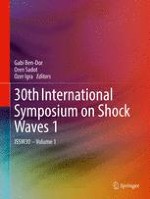2017 | OriginalPaper | Chapter
Oscillatory Behaviors of a Hypersonic Inlet with Trips
Authors : Wenzhi Gao, Shuaitao Guo, Zhufei Li, Jiming Yang
Published in: 30th International Symposium on Shock Waves 1
Publisher: Springer International Publishing
Activate our intelligent search to find suitable subject content or patents.
Select sections of text to find matching patents with Artificial Intelligence. powered by
Select sections of text to find additional relevant content using AI-assisted search. powered by
